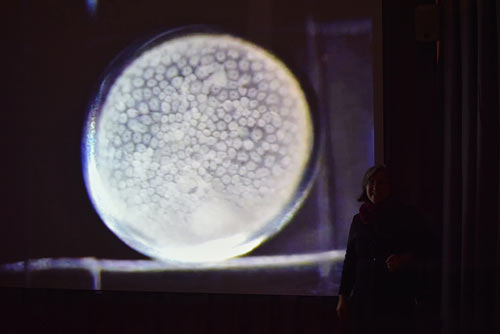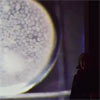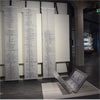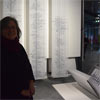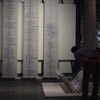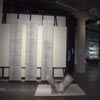Exo Global
Curated by Peter Weibel
Catalogue (pdf)
WORKS IN SHOW:
CELLULAR
12 min.
Digital Film made with Atonics Micro fire digital cameras mounted on Olympus stereomicroscopes. Sound made with an atomic force microscope (AMF)
Cellular is a film of a blastopore, or a multiple-cell embryo. More than 200 hours of still images of each embryo were made with Atonics Micro fire digital cameras mounted on Olympus stereomicroscopes and made into a film using Astor IIDC imaging software. The film Cellular is combined with the recording of the sound of cells dividing.
Since 2003, nanotechnology and the AMF (atomic force microscope) enables researchers to also touch a cell. Like the blind reading braille or a finger touching the pulse, the needle of the AMF can touch cells which are less than half the diameter of a human hair. This touch can also record the sound the cell emits when dividing or dying. What we can now listen to within a cell has revolutionized our knowledge of cellular gestation, division, and relationships with the interior architecture of our body.
CASE STUDY 22 CHROMOSOMES X & Y, 2011
Front panel: Jacquard dye and hand embroidery on dye sublimation, printed sheer silk. Back panel: Laser-printed linen 20” x 9’
Laser-cut plexi-box, steel stand, Open 36” x 40” x 24” x 10”, Closed 24” x 40”
Collection: The Portland Art Museum
Case Study delineates the human genome, organized into 22 human autosomal chromosomes, the two sex chromosomes X and Y, and genetic markers and identification, using the NCBI database. In this piece, graphic genetic representations of chromosomes are printed onto sheer synthetic silk, accompanied by the names of genes linked to discernible traits and genetic diseases present in my own extended family.
The 24 scrolls are each made of a layer of ultra-sheer silk on top of linen and printed with the graphic representation for all 24 human chromosomes. The cloth has been digitally printed, hand painted, and selectively embroidered to highlight markers on each chromosome. Those highlighted parallel the location of various qualities and anomalies.
Each cloth representation of the chromosome is rolled and housed within a large closeable case inscribed with “Case Study”. The total presentation is meant to appear like the casing for religious scrolls kept in storage for future reading. The scrolls represent the genetic archive that is in each of our bodies. With this in mind, I have highlighted the qualities of the past generation as well as the present.
PETER WEIBEL: INTRODUCTION TO THE EXHIBITION
The exhibition focuses on the artistic use of new technologies and opens views into the future, in various modules. It shows us our new reality, which is shaped by 3-D printers and robots; cyborgs and chimeras; molecules and gene pools; wearable technologies and medical miracles; synthetic life forms, bionic suits and silicon retinas; artificial tissue and repair techniques; and new discoveries in space research, molecular biology, neurology, genetics, and quantum information science. It shows us visions and solutions for twentieth-century problems, such as separating oxygen out of CO2 to combat the climate crisis.
When humans began walking upright, feet turned into hands. Human beings used their hands to create works. These works included tools. Walking upright set human hands free to be used as tools, making human beings themselves “the first of the creation left [sic] free” (J. G. Herder, Outlines of a Philosophy of the History of Man, 1803).
From manual to mental tools, from the hammer to language, over the course of thousands of years human beings have created a culture of tools, an engineering culture that has expanded the boundaries of perception and of the world. The human being has outsourced his bodily functions: the hand to the hammer, the foot to the wheel, the arms to the bow and arrow, the spoken word to the written word, memory to clay tablets and computers, etc. Through the chain of rendering things exterior, the human being transcends evolution. He liberates himself from the violence of nature; he creates an artificial exo-evolution through his tools and through organs made exterior. From exo-biology to exo-planets, from exo-skeletons to exo-pregnancy, the contours of a new world deeply marked by technology are taking shape. In the early twenty-first century, art also can no longer stand apart from this technological development.
Traditionally art was focused on representing that which the human eye naturally perceived. When rendering the world of objects visible, painters were trapped in retinal effects and limited to the surface of things. From the microscope to computed tomography, technologies of perception have developed in science. Objects unrecognizable to the naked eye have been artificially made visible. New media bring the technologies of artificial perception, from photography to the computer, into the realm of art. This creates a new awareness of the interconnection of natural and artificial perception, of the object world and the media world, and of art and science. Media are not, however, merely image and sound machines; they are also interfaces in the construction of new realities and new forms of communication. We communicate, negotiate and act through media. The transformation from visual to social media makes clear that the use of media is a vital factor. Media are performative. Their impact is ubiquitous and long-lasting. That is why we speak not only of pictures, but rather of picture acts (Bildakten); not only of language, but of language acts; not only of perception but of acts of perception. Actions have become art forms. Now that a certain amount of overlap exists between the tools of artists and those of scientists, artists’ studios sometimes resemble scientific laboratories, and vice versa. Artists today are less in search of subjective expression. Rather, their frames of reference are social systems and scientific structures and methods. This is the reason for new research areas such as art and science labs and art-based research. Scientization of art is beginning to emerge as it did during the Renaissance, creating a sort of Renaissance 2.0.
PARTICIPATING ARTISTS
::vtol:: 1024 architecture · Yuri Ancarani · Jinsoo An · Alisa Andrasek · Alisa Andrasek & Jose Sanchez · Suzanne Anker · Anthropocene Observatory Artificial Nature (Haru Ji & Graham Wakefield) · Lise Autogena & Joshua Portway · Nurit Bar-Shai · Sonja Bäumel · Sonja Bäumel & Manuel Selg · Ursula Biemann & Paulo Tavares · Howard Boland & Laura Cinti (C-LAB) · Ecke Bonk / typosophes sans frontiers · Adam W. Brown & Robert Root-Bernstein · Oron Catts & Ionat Zurr & Corrie Van Sice · Center for PostNatural History · Jürgen Claus · Sam Conran · Hermann Cuntz · Hermann Cuntz & Marvin Weigand · Theresa Dankovich · Robert Darroll · Caitilin de Bérigny · Frederik de Wilde · Thierry Delatour · Louis-Philippe Demers & Bill Vorn · Heather Dewey-Hagborg · Kitsou Dubois · Anna Dumitriu · ecoLogicStudio · Electronic Shadow (Naziha Mestaoui & Yacine Aït Kaci) · Peter Fend / Ocean Earth · Thomas Feuerstein · Verena Friedrich · Klaus Fritze · FZI Forschungszentrum Informatik · Eyal Gever · Alexandra Daisy Ginsberg · Alexandra Daisy Ginsberg & Sascha Pohflopp · Niklas Goldbach · Andy Gracie · Tue Greenfort · Terike Haapoja · History of Others (Terike Haapoja, Laura Gustafsson) · Zaha Hadid Architects · Stephen Hawking · Ivan Henriques · Camille Henrot · Lynn Hershman Leeson · Bart Hess · Heurisko Gesellschaft für Biologische Technologien GmbH & Karlsruher Institut für Technologie · Chris Jordan · Manfred Kage · Wanuri Kahiu · Felix Kemner · KIT | Institut für Meteorologie und Klimaforschung · Allison Kudla · Nandita Kumar · Ebru Kurbak & Irene Posch · Christian Lölkes & Adrian Vielsack · Andy Lomas · Wolfgang Mally · Daria Martin · Mediated Matter Group | MIT Media Lab · Agnes Meyer- Brandis · Yann Mingard · MVRDV & The Why Factory (in Kooperation mit MOON Kyungwon & JEON Joonho) · Dave Murray-Rust & Rocio von Jungenfeld · Michael Najjar · Geraldine Ondrizek · Lucy & Jorge Orta · Neri Oxman · Geoffrey Ozin · Tariq Rahman · Reynold Reynolds · Byron Rich · Adam G. Riess · robotlab · Hermann J. Roth · Scenocosme (Grégory Lasserre & Anaïs met den Ancxt) · HA Schult · SEAD (Space Ecologies Art and Design) · Conrad Shawcross · Semiconductor · Maja Smrekar · Studio Swine · Luisa Székely · Yesenia Thibault-Picazo · Luca Trevisani · Troika · UdK | Design Research Lab · Andrei Ujica · Koen Vanmechelen · Paul Vanouse · Aline Veillat · Pinar Yoldas · Martin Walde · Peter Weibel, · Daniel Widrig · Where Dogs Run
EXO-EVOLUTION, PETER WEIBEL
The industrial revolution was clearly machine-based. From the steam machine to automobile and film projector, it was dominated by a technology based mainly on the technical principle of the wheel. These machines were, on the one hand, accelerators; but, as artificial tools, they also assumed, in improved form, the tasks of natural organs: What the leg couldn’t achieve, the wheel did; what the eye couldn’t achieve, the telescope did; what the voice couldn’t, megaphones and microphones achieved. The machine-based industrial revolution and the information-based postindustrial revolution have created the technical prerequisites for a development we may call the exo-evolution.
“The human is the first of creation let free; he stands upright. The scales of good and evil, of false and true, hangs inside him: He can research, he is to choose.”
-Johann Gottfreid Herder
Already in 1791, Johann Gottlieb Herder presented a vision of the impact of the industrial revolution as a turn in the history of ideas, when he formulated: “The human is the first of creation let free; he stands upright. The scales of good and evil, of false and true, hangs inside him: He can research, he is to choose. Just as nature gave him two free hands as tools and an overlooking eye to guide his steps, he has the power not only to place the weights, but also, if I may say so, to be a weight himself upon the scale.”1 Herder’s equation “our earth is a star among stars”2 prefigures Richard Buckminster Fuller’s idea that the earth is a spaceship with limited resources and a missing operating manual:
“So, planners, architects, and engineers take the initiative. Go to work, and above all cooperate and don’t hold back on one another or try to gain at the expense of another. Any success in such lopsidedness will be increasingly short-lived. These are the synergetic rules that evolution is employing and trying to make clear to us. They are not man-made laws. They are the infinitely accommodative laws of the intellectual integrity governing universe.”3
It is not only the modern era that is an unfinished project – the human being, the earth, and the world are unfinished, open projects too, that will be transformed by further revolutions. We currently find ourselves at the beginning of the digital revolution. Herder indicates the key idea, that the upright walk was nature’s way of freeing humans’ feet to become hands, allowing them to transform from natural organs into technical tools. This pre-formulates the development of humans during the industrial revolution; i.e., the transition from organs to tools; from natural sensory organs to machines, media, and apparatuses; from nature to technology. Herder defines this transition positively, as a moment of freedom. Released from the prison of nature, human beings wind up as freehanded cultural beings4 (Kurt Bayertz) in the free port of technology. Yet this freedom of choice also always entails human beings submitting themselves to choice – and facing choices. Herder’s metaphor, that the human being not only has the power to place the weights, but is himself a weight on the scale, highlights the idea of recurrence, of going back – the human being is part of the system that he observes, in which he selects and weighs.
“I call this exo-Darwinism.”
-Michael Serres
Through the technical and industrial revolution, humans have once again become beings let free, namely let free from evolution. This process, this stepping out of the process of natural evolution, I call exo-evolution.
From exo-biology to exo-planet, from exo-skeleton to exo-pregnancies – the increasingly differentiated contours of a new world appear, one with a profoundly technological stamp. The term exo-evolution is an extension of Michel Serres’ term exo-Darwinism:
“But what is true of purely physical functions – with regard, for example, to hammer, wheel, etc. – is also true of intellectual functions (fonctions intellectuelles), and indeed you can clearly see that memory has become materialized: in writing, in printing, in computer science. The body actually loses – it loses these objects, which become conveyors of an evolution that we call technical evolution, scientific evolution, etc. I call this exo-Darwinism.”5
In 1877, in his Grundlinien einer Philosophie der Technik [Principles of a Philosophy of Technology], Ernst Kapp formulates his organ projection theory, which states that, in the final analysis, all technical artifacts are reproductions and projections of organs; for example, the hammer reproduces the fist, the saw reproduces incisors, telegraphy reproduces the nervous system, and so on. Therefore, the technical evolution is a multiple exteriorization, an outsourcing of natural physical organs and functions, as well as mental functions, to technical machines: human arms to bow and arrow, speaking to writing, memory to clay tablets and computers, and so on. The media theory that follows this paradigm of extending bodily functions is thus an organology, describing the transformation from natural organs to technical tools. The technology of an era is thus understood as the outsourcing – exteriorization and externalization – of already existing organic and intellectual human properties. At the same time, this understanding of technology and media is based on an anthropology that defines the human being as a deficient creature being improved by technology. This dialectic of human being and mechanics, of nature and technology, of organs and tools, was first formulated in ancient Greece and is still alive today, for example in psychoanalysis. The Greek goddess of helplessness was named Amechania. In Greek, a stands for negation (atomos, for example, being that which is not divisible). Mechania thus means help, helpfulness. If a rock is too heavy for a human, he uses a lever to move the stone – this is the idea of mechanics: an enhancer of human ability, or a compensation for lacking natural abilities. Technology is thus nature humanized by humans; in short: Technology is human-made nature.
“Man has, so to speak, become a kind of prosthetic God – quite magnificent when he dons all his auxiliary organs.”
-Siegmund Freud
In his 1924 Notiz über den ‘Wunderblock’; [A Note upon the Mystic Writing Pad] Sigmund Freud writes, “Auxiliary apparatuses […] are all built like the sensory organ itself or parts thereof […].”6 And in his 1930 Das Unbehagen in der Kultur [Civilization and Its Discontents], he explains,
“With all his tools, man is perfecting his organs – the motoric, as well as the sensory – or is removing the limits to their functioning. Motors place gigantic forces at his disposal, which, like his muscles, he can send in any direction […]. With spectacles, he corrects defects of the lens of his eye, with the telescope he gazes into remote worlds, with the microscope he overcomes the bounds of visibility set by the construction of his retina. With the photographic camera, he has created an instrument that captures fleeting visual impressions, which he also demands from the gramophone record with respect to his equally ephemeral auditory impressions […]. With the aid of the telephone, he can hear at distances that, even in a fairy tale, would be respected as unattainable; writing is originally the language of the absent person; the dwelling a substitute for the womb, the first housing, for which we probably still long, in which we were safe and felt so good. It not only sounds like a fairy tale, it is a direct fulfillment of all his – no, of most – fairy tale wishes: the things that man through his science and technology has created on this earth, on which he first appeared as a weak animal creature, and on which each individual of his species must once more make his entry as a helpless suckling (‘oh inch of nature!’). […] Man has, so to speak, become a kind of prosthetic God – quite magnificent when he dons all his auxiliary organs, but they have not grown onto him and still give him much trouble at times. He is entitled, by the way, to console himself with the thought that this development will not be completed precisely with the year AD 1930. Future ages will bring with them new, probably unimaginably great advances in this field of civilization, and will increase man’s likeness to God even further.”7
Thus, every technology is tele-technology, the overcoming of chronical and spatial distances (tele in Greek): telefax, telephone, television. With these machine or media supported, as well as unnatural or superhuman, skills of man, every tele-technology – indirect and secretly – becomes a theo-technology; a technology, that makes humans godlike in their imagination.
“Each new technology is the reprogramming of sensory life.”
-Marshall McLuhan
Marshall McLuhan laid out his understanding of media as an extension of the human sensory organs (an understanding that is quite similar to Freud’s) in 1964, in his Understanding Media: The Extensions of Men. Earlier, in a 1956 essay, he had written, “Each new technology is the reprogramming of sensory life.”8 What he meant was, firstly, that the relationships between the sensory organs are reprogrammed; and, secondly, that the relationship of the sensory organs to their surroundings is reprogrammed. In a word, our entire sensory life is reprogrammed by the media, the machines, and technology.
Another witness of the connection between machines and life, exo-evolution, and evolution, is Samuel Butler. A few years after the 1859 publication of Charles Darwin’s theory of evolution – in On the Origin of Species by Means of Natural Selection, or the Preservation of Favoured Races in the Struggle for Life – in 1872, Butler published his utopian novel Erewhon (the title is an anagram of the word nowhere). In the chapter “Book of the Machines”, he projected his concept of natural evolution onto the mechanical world. Nine years earlier, in the essay upon which this chapter is based, Butler had already described the idea of mechanical life, i.e., artificial life; and compared the idea of natural evolution with the evolution of machines: “We find ourselves almost awestruck at the vast development of the mechanical world, at the gigantic strides with which it has advanced in comparison with the slow progress of the animal and vegetable kingdom.”9
George Dyson expanded on this idea in two publications. In 1998, in Darwin Among the Machines. The Evolution of Global Intelligence, he presents the theory of the Internet being a conscious, living creature. In Turing’s Cathedral. The Origins of the Digital Universe (2012), he accurately describes the evolution of the digital universe. Accordingly, from manual to mental tools, human beings have over the course of millennia evolved a tool culture, an engineering culture, extending the bounds of perception and of the world.
From microscope to computerized tomography, the technologies of perception in science have advanced. Objects undetectable to the natural eye were made visible by means of apparatuses. The new media are introducing the technologies of apparatus-aided perception, from photography to computer, into the realm of art. This creates a new awareness of the interconnectedness of natural and apparatus-aided perception, of object world and media world, of art and science. Media are not merely image and sound machines, but also interfaces for constructing new realities and new communication forms.
“By not only leaving the field of engineering culture to the sciences, art follows up to other epistemic systems, which explain and change the world.”
-Peter Weibel
Now that artists and scientists have a certain range of tools in common, the studios of artists occasionally look like the laboratories of science, and vice versa. Modern-day artists are less focused on seeking subjective expression; their frames of reference are social systems, as well as the structures and methods of the sciences. Against this background, such new research and perspectives as art-based research (AR) and art & science labs are evolving. A scientification of art like in the Renaissance epoch of art history is emerging: a Renaissance 2.0.
The exhibition Exo-Evolution sets its focus on the artistic application of new technologies, offering views of the future and the past with its modules. It shows us a new reality formed by 3-D printers and robots; cyborgs and chimeras; molecules, and gene pools; wearable technologies and medical miracles; synthetic beings, bionic suits, silicon retinas, artificial tissue, and biotechnical repairing methods; findings from aerospace research, molecular biology, neurology, genetics, and quantum computing. And it shows us visions and solutions for problems of the 20th century; for example, splitting off oxygen from CO2 (carbon dioxide) to cope with the climate crisis. With their natural organs of perception, humans can only cover a limited frequency range, and operate in a narrow sphere. The eyes, the ears, the hands, and the lungs are evolution’s responses to natural conditions including sunlight, sound waves, and atmosphere.
Painting and music – the art forms of the hand and the mouth for the eye and the ear – are the human being’s first responses to evolution that utilize these two natural sense organs, brought forth by evolution itself, and manufactured instruments contrived by human beings within the limited range of frequencies or wavelengths visibly or aurally accessible to humans. New electronic and digital art forms, such as film, video, and computers that use the extended spectrum of electromagnetic waves conquered by humans 130 years ago, began to appear around the mid-20th century. With these tools and meta-tools, man creates a new exo-universe. By not only leaving the field of engineering culture to the sciences, art follows up to other epistemic systems, which explain and change the world. This new form of art aims for solutions like the exo-evolution itself and thus itself becomes part of the exo-evolution.
INDEX
- Johann Gottfried Herder, Ideen zur Philosophie der Geschichte der Menschheit [Outlines of a Philosophy of the History of Mankind], 1784–1791, 2 vols, vol. 1, Berlin, Weimar, 1965, p. 144; translated from the German by Lonnie Legg.
- Ibid., p. 17.
- Richard Buckminster Fuller, Operating Manual for Spaceship Earth, Simon Schuster, New York, 1968, last paragraph.
- Kurt Bayertz, Der Aufrechte Gang [Upright Walking], C.H. Beck, Munich, 2012; translated from the German by Lonnie Legg.
- Michel Serres, interview in: Regards Sur le Sport. Michel Serres, Philosophe Images. Une Documentaire de Benjamin Pichery, Insep, Paris, 2009 (DVD); English translation by Lonnie Legg.
- Sigmund Freud, Notiz über den ‘Wunderblock’ [A Note upon the Mystic Writing Pad], 1924, in: Studienausgabe, Vol. 3: Psychologie des Unbewussten, Fischer, Frankfurt am Main, 1975, pp. 363 – 369, here p. 366; translated from the German by Lonnie Legg.
- Sigmund Freud, Das Unbehagen in der Kultur [Civilization and Its Discontents], 1930, in: Das Unbehagen in der Kultur und Andere Kulturtheoretische Schriften, Fischer, Frankfurt am Main, 1994, pp. 57f; translated from the German by Lonnie Legg.
- Marshall McLuhan, David Carson, The Book of Probes, Gingko Press, Corte Madera, 2003, pp. 162f.
- Samuel Butler, Darwin Among the Machines. To the Editor of the Press, Christchurch, New Zealand, 13 June, 1863, in: idem, A First Year in Canterbury Settlement With Other Early Essays, A. C. Fifield, London, 1914, pp. 179–185, here p. 180. [check this for errors]
